How to Read Electrical Diagrams?
In this article, you’ll learn how to read, understand and use a wiring diagram.
An electrical wiring diagram could be a single page schematic of how a ceiling fan should be connected to the power source and its remote switches.
A wiring diagram may include the wirings of a vehicle. For example, how the horns are powered and connected to the controller on your steering wheel.
Or an electrical wiring diagram can be a 200-page document including all the electrical wirings of an electrical control panel in a huge factory or plant.
As some rules of thumb will be applied to most of the wiring diagrams, in Part 1 of this multi-part article you’ll learn how to read a wiring diagram by means of an actual industrial control panel’s wiring diagram.
And in Part 2, you’ll learn how to read a PLC wiring diagram and its modules.
Spend Some Time on Understanding the Standards!
Wiring diagrams may follow different standards depending on the country they are going to be used.
They may have different layouts depending on the company and the designer who is designing that.
They also may be drawn by different ECAD software such as EPLAN or AutoCAD electrical. So, when you see a wiring diagram for the first time, you may need some time to analyze it and become familiar with its layout and symbols.
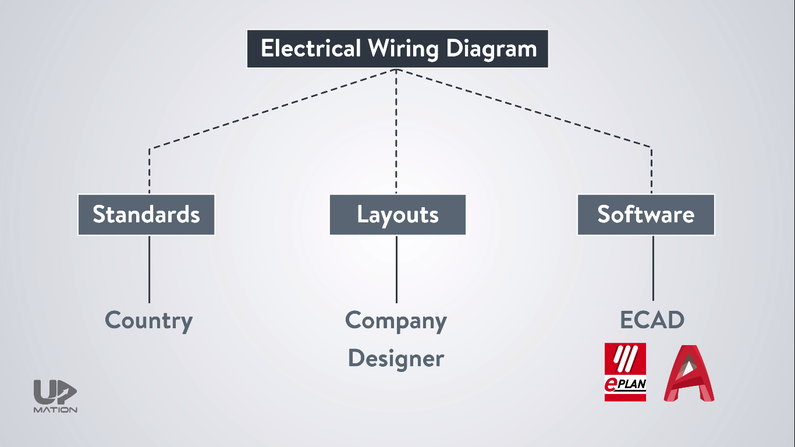
Let’s start with an actual example of a wiring diagram.
The document we are going to check includes more than 140 pages but we’ll check only some of the pages as the rest of them are somehow similar.
First Things First! Wiring Diagram Symbols
Every wiring diagram includes:
– Hardware components,
– Power sources,
– Ground chassis,
– Terminals,
– Some wires of course!
– Numbers, letters, and maybe some nomenclatures.
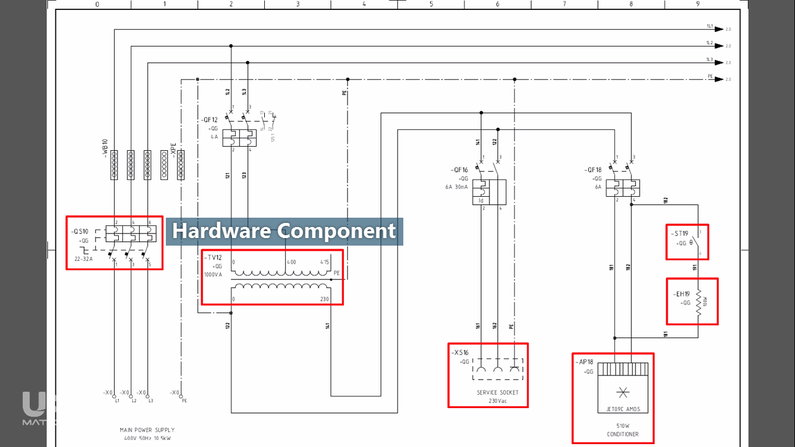
Normally the very first step to learn reading a wiring diagram is becoming familiar with the symbols of the equipment and each wiring diagram is supposed to have a page or two for this purpose.
This page is known as Legend and abbreviation page.
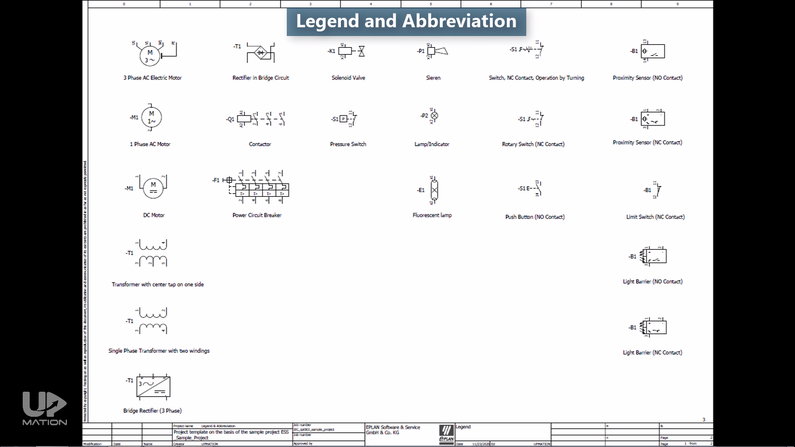
In the Legend and Abbreviation page you can see:
– A three-phase AC electric motor symbol
– A solenoid valve symbol
– An MCCB with thermal and short circuit protection
– A contactor (the coil and its contacts)
and all the other electrical symbols you need to read the wiring diagram.
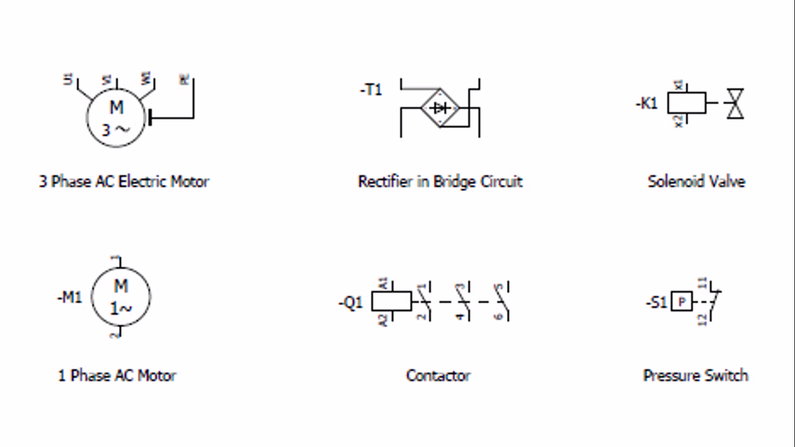
Remember that these symbols may have some minor differences in different wiring diagrams depending on the ECAD software they have been designed with.
As an example, the Fuse in EPLAN Electric P8 (a Wiring Diagram Software) looks like this:
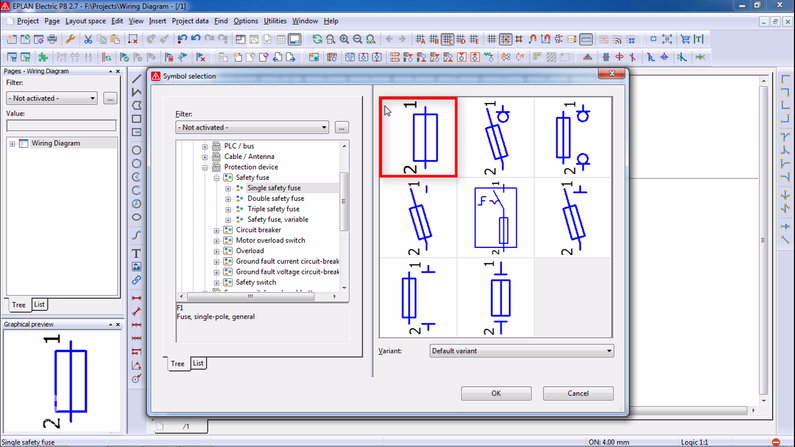
But in AutoCAD electrical, it looks like this:
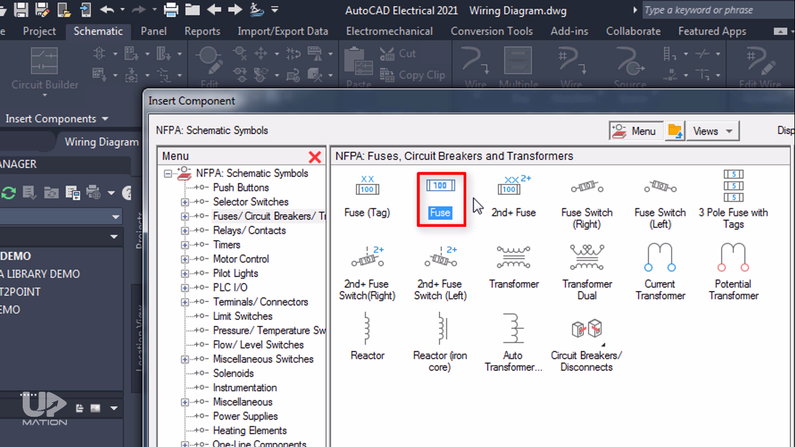
By the way, you’ll learn more symbols in the rest of this article and you’ll get used to these electrical symbols very soon!
Wiring Diagram Rules of Thumb!
Ok, let’s start with the first page to see how much it could be easy to read and understand a wiring diagram.
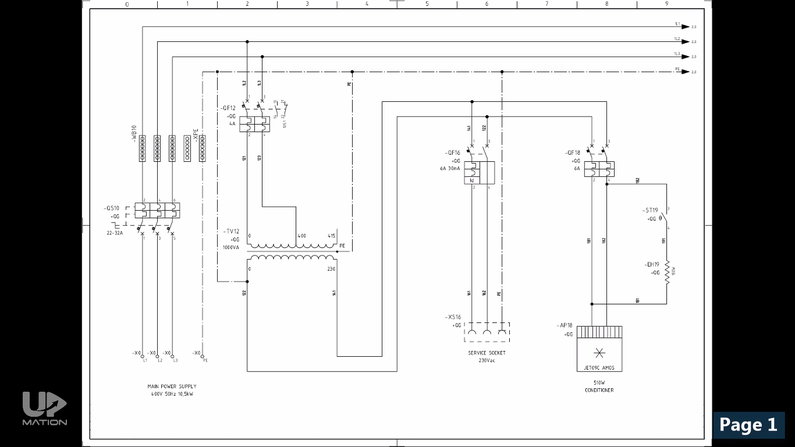
Rule #1: How to Follow a Wiring Diagram (Reading Direction)
First of all, there is a rule of thumb in standard wiring diagrams that you should read the diagram from left to right and from top-down.
Exactly like reading a book!

But sometimes, designers make some exceptions to have a better layout such as this page.
So as an exception, we should start from the downside and this is where the three-phase power enters the panel.
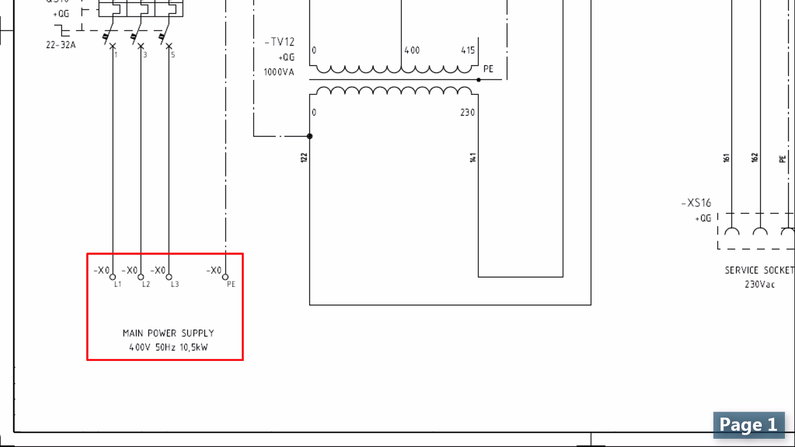
As a reminder, the voltage level and the frequency of the power depends on the country we’re implementing our project.
For example:
– In England or Austria, the voltage level is 400 volts with 50 hertz of frequency
– In the United States, a three-phase power source will produce 480 volts with 60 hertz of frequency.
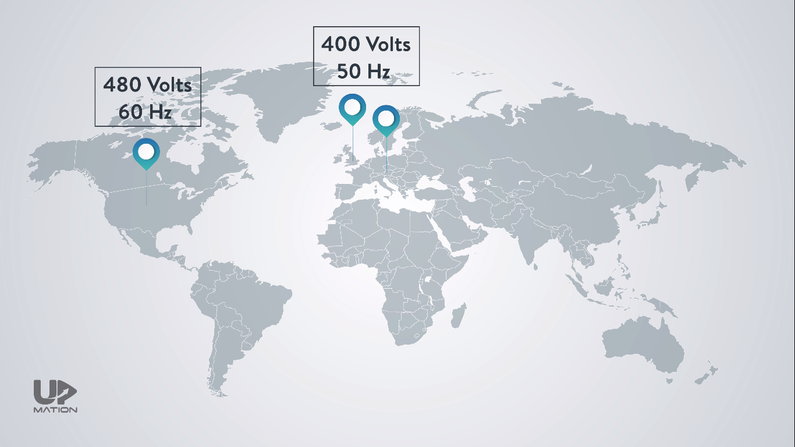
The power enters the terminal blocks with the “X0” terminal strip.
The terminal strip is a mark that refers to a group of terminal blocks with the same voltage level or the same purpose.
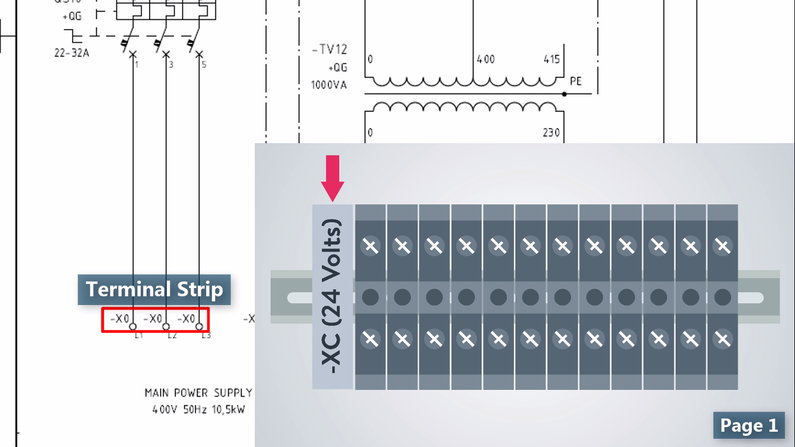
From these terminal blocks, we move on to a three-pole circuit breaker with thermal and short circuit protection capability.
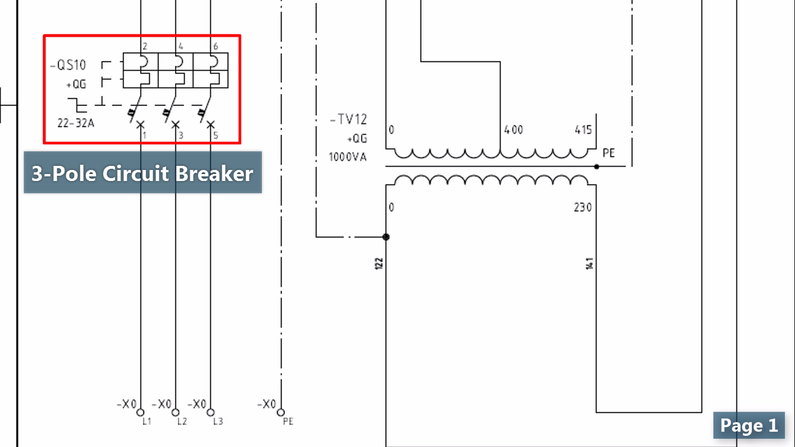
Rule #2: Wiring Diagrams Are Drawn in the Neutral Condition
Every standard wiring diagram should be drawn in the neutral condition.
This means that all of the contacts, contactors, circuit breakers, etc., are shown in their normal or non-energized condition.
Therefore, when you see a closed contact in an electrical wiring diagram, that is a normally closed contact and the rest of the contacts should be open.
We have a great article about NO and NC contacts and their actual application examples that you can read it here.
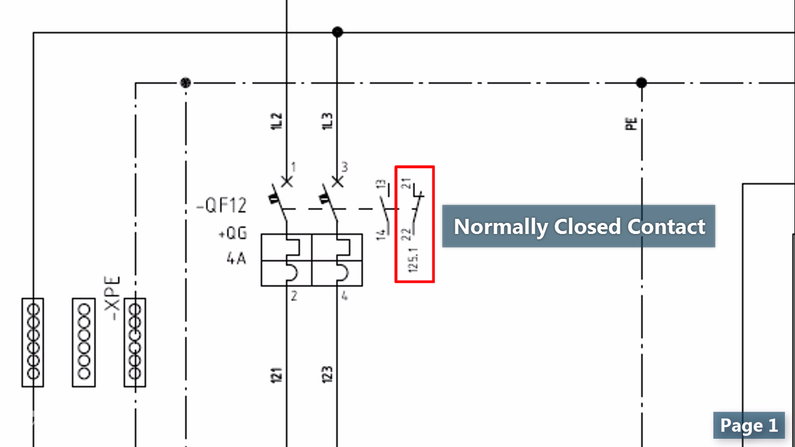
How to Read Wiring Diagrams
Ok! Let’s continue reading.
After closing this circuit breaker manually, the power flows toward some power distributer bars, from which some branches can be taken.
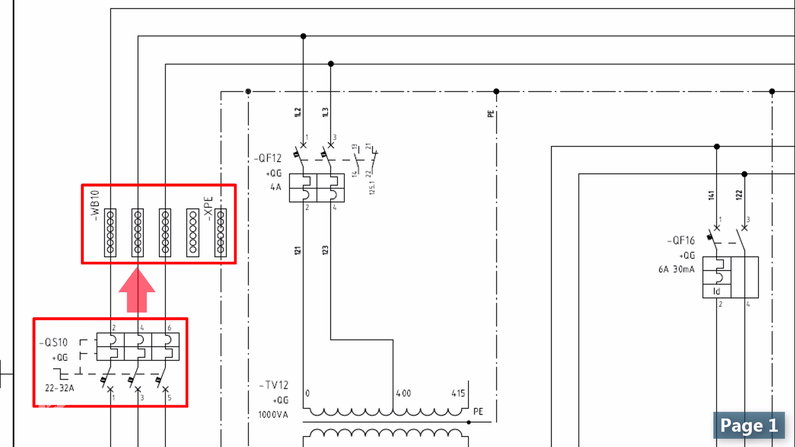
One of the branches goes into a two-pole circuit breaker.

and from there powers a transformer.
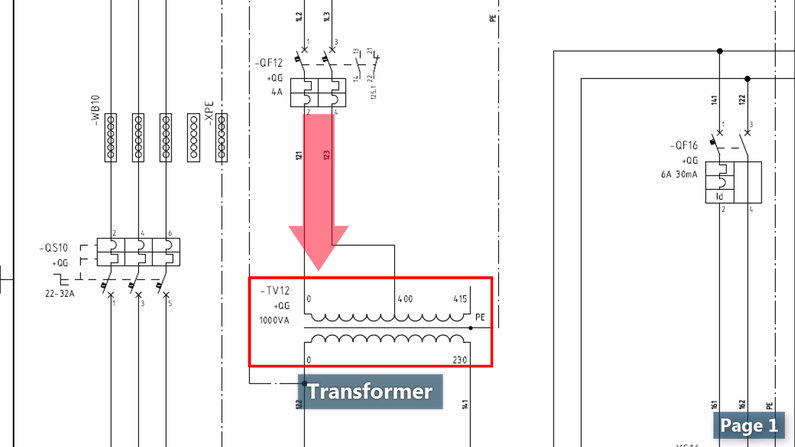
If you’ve noticed, there are some numbers on the wires.
These are called “wire tags”.
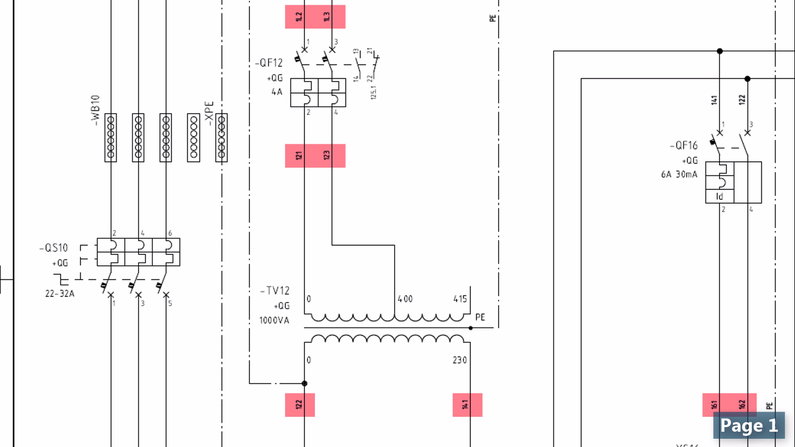
What is a Wire Tag? (And Device Tag)
Wire Tags are the combination of some letters and numbers installed on the wire or cable and are used to show you to which device or terminal block a wire or a cable should be connected.
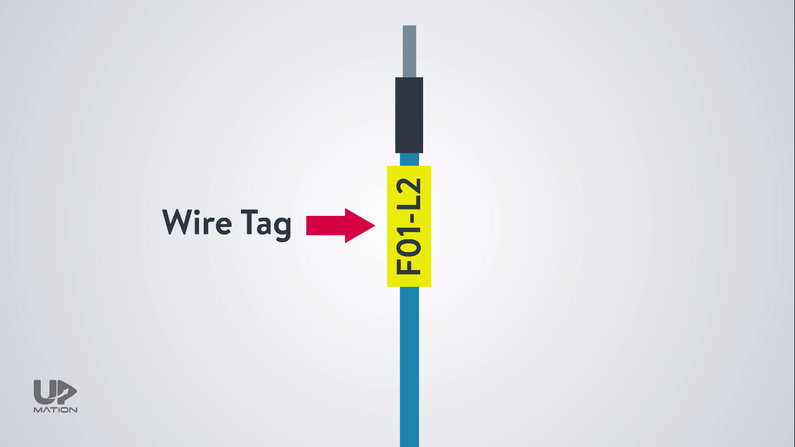
Wire tags are very helpful in case of troubleshooting so that when a wire gets out of its connection point, you can easily look at the wiring diagram and figure out where it should be connected again.
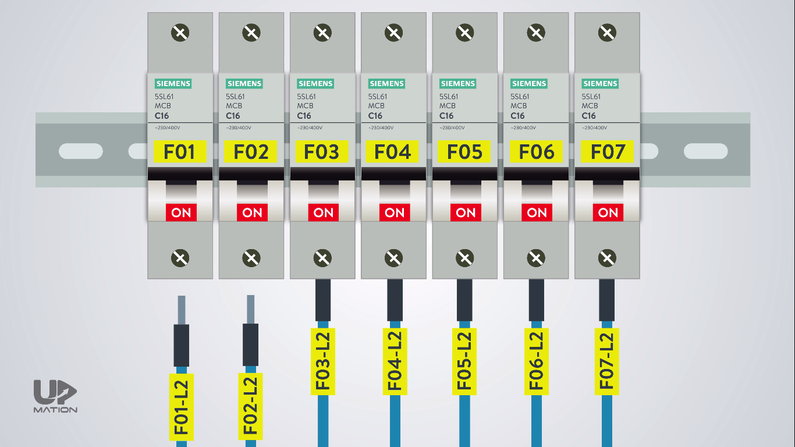
There are the tags for the devices within the panel as well.
If you were looking at the wiring diagram and you didn’t know what a device is, then you could find it in the panel using its tag.
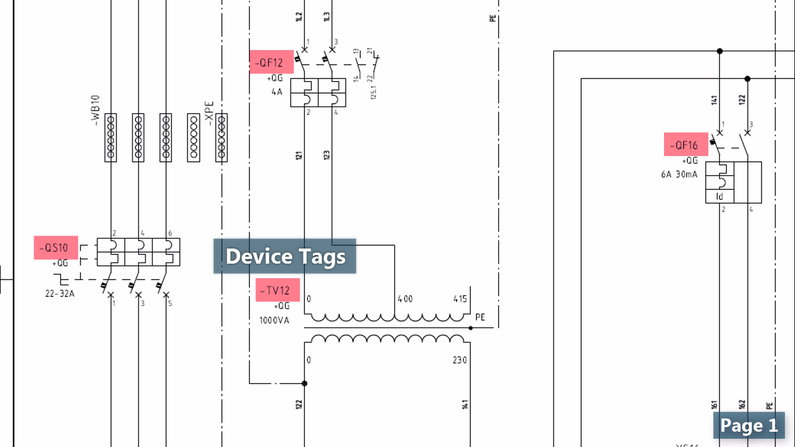
This transformer converts the 400 volts to a single-phase 230 volts.
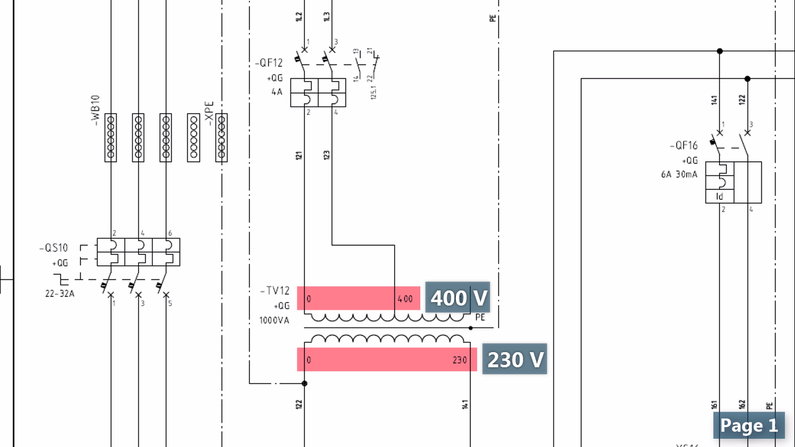
It is used to feed the power receptacle or socket, the heater, and the fan.
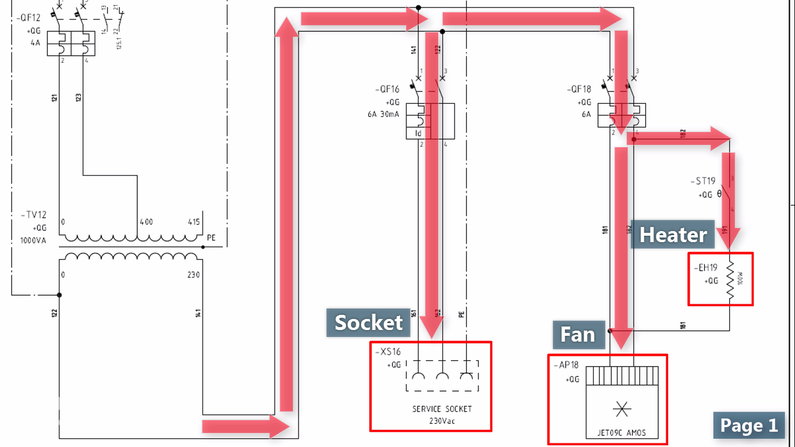
The “-ST19” tag refers to a thermostat to turn on and off the heater or the fan on its specified temperature setpoints.
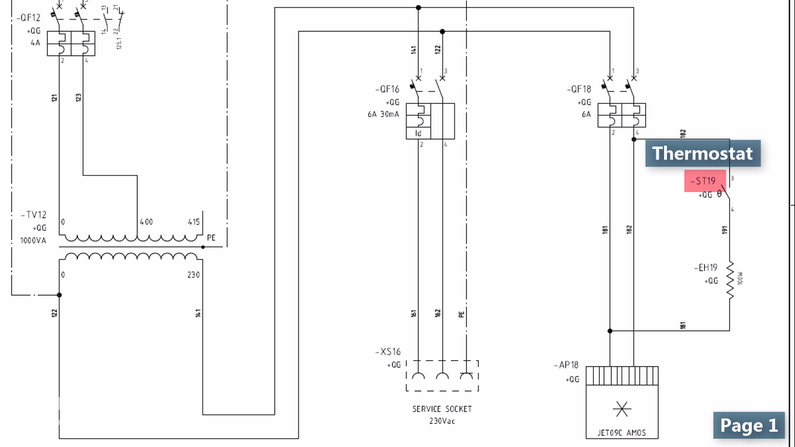
You’ve also noticed the earthing chassis and its branches wherever it’s needed.
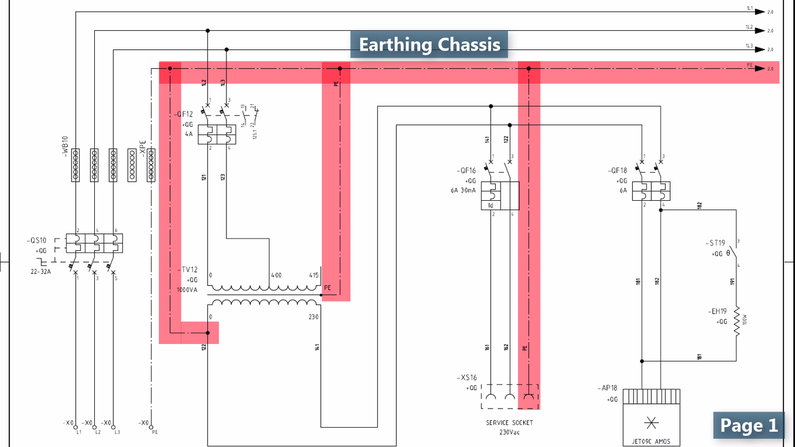
How to Address a Component in Wiring Diagrams
Before we continue to the next page, you may ask what these numbers on top of the page are. This is a very good question!
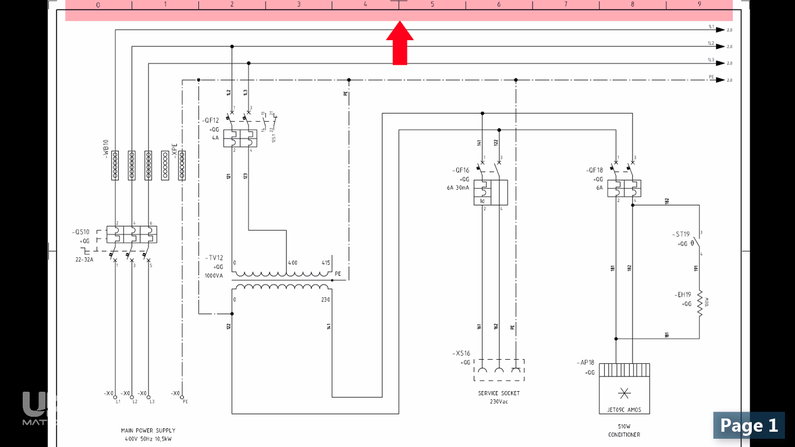
Actually, these are the column numbers and they have divided each page of this drawing to 10 columns.
As you see, there are some devices in each column and we can use these column numbers in combination with the page number to address different devices, contacts, terminal blocks, and so on, in other pages.
Let me explain it by some examples!
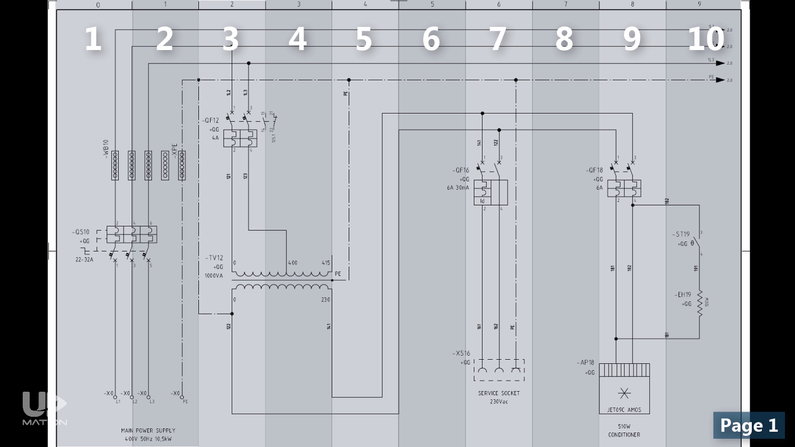
For instance, the main three-phase power is shown with some arrows and numbers on the top right-hand side of the page.
All of them have a 2.0 number just beside the arrow.
– By “2” it refers us to page two.
– By “0” it points out to the first column of page two.
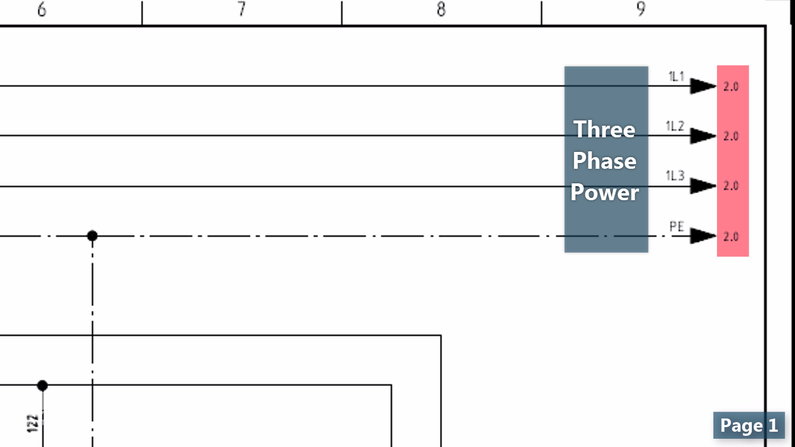
And there you go! It’s our power source on page two.
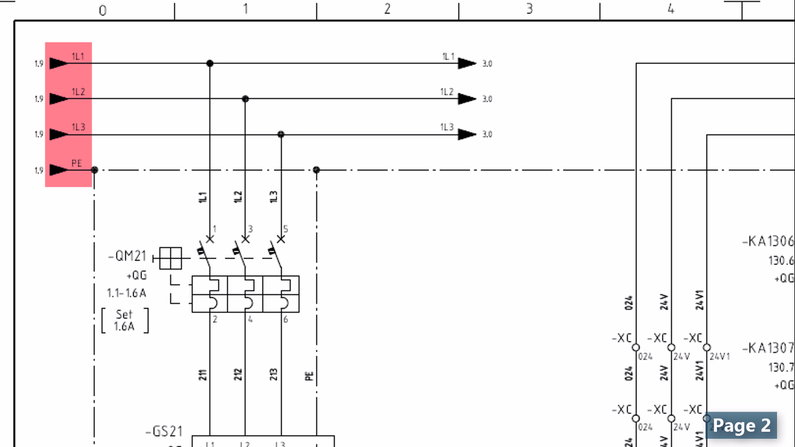
As another example, the number below this contact says page 130 and column 6.
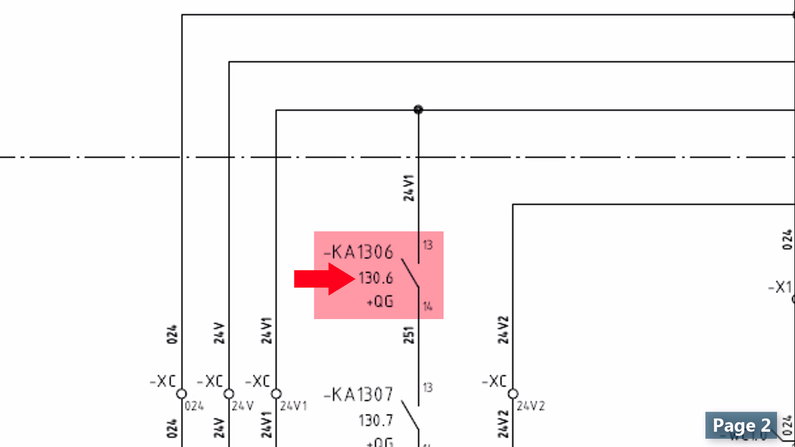
I’ll turn to page 130 of the wiring diagram and this is column number 6.
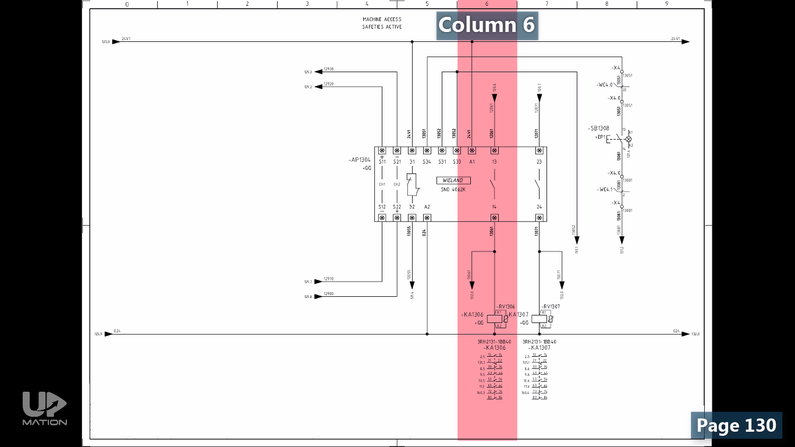
And there it is! The same tag, KA1306 as we had expected.
It looks like a coil. But not the coil of a contactor; the coil of a relay.
And how do I know that?! If you have seen the legend and abbreviation page of the drawing you know that the “-KA” is a nomenclature for a relay in this drawing.
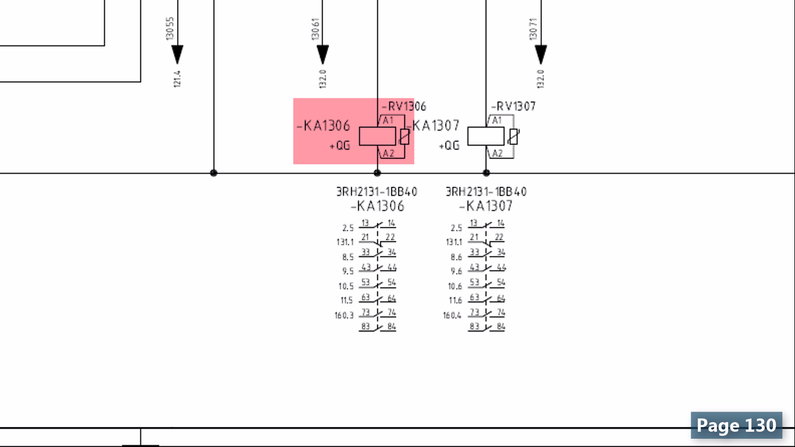
Below the coil, you see the 13-14 contact (NO Contact) of page two and also the other NO and NC contacts of this relay with the addresses they have been used in this drawing.
We’ll get back to this page again.
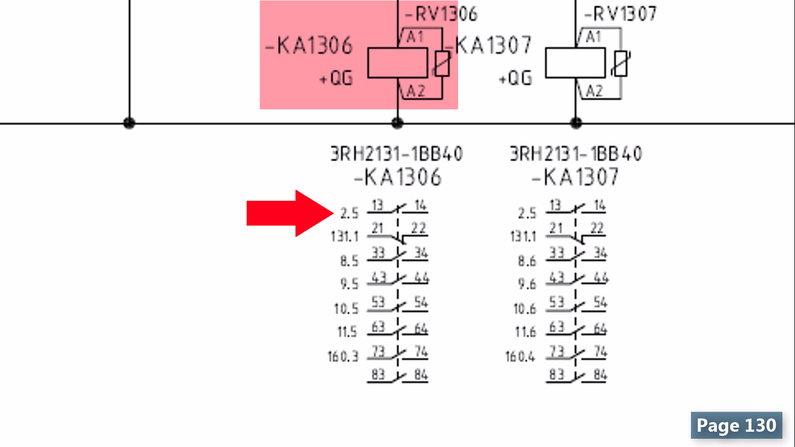
On page two, the mains power source is feeding a 24-volt power supply and it provides us with a voltage of 24 with 10 amps of capacity.
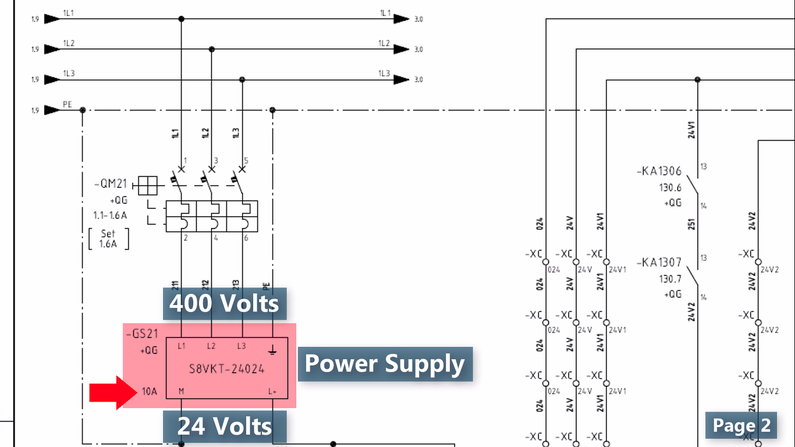
From there, we have extended this voltage using some terminal blocks so that we can deliver the power to different instruments, PLC cards, PLC CPU, or whatever device which needs 24 volts to power on.
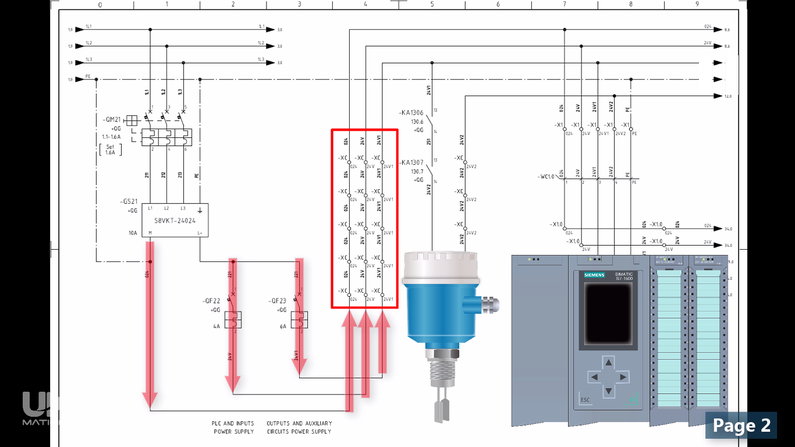
But wait! This part of the drawing, seems a little bit strange as all of these terminal blocks have the same tag of “XC”.
What are Double-Level Terminal Blocks?
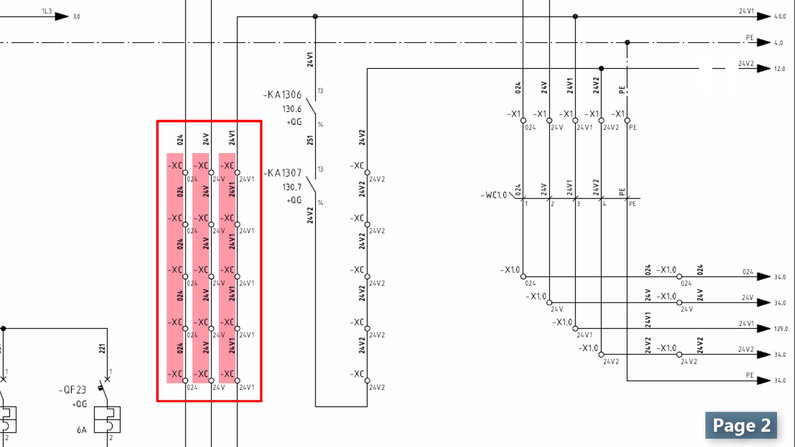
There are a variety of terminal blocks in the market. In this case, to save some space in the panel, we have used some double-Level terminal blocks.
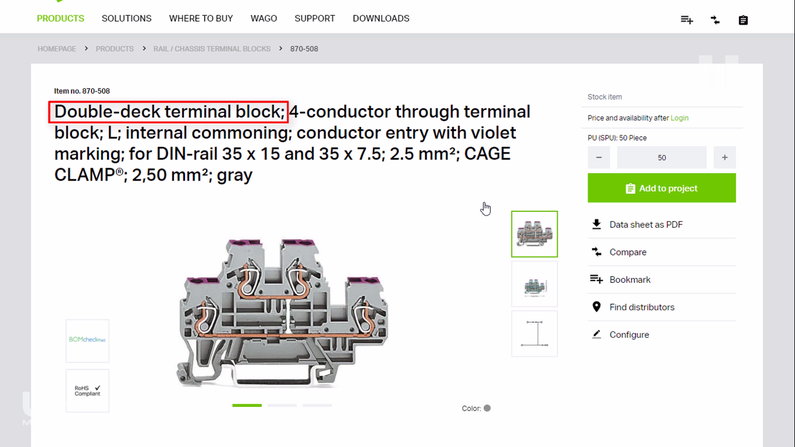
They occupy the same space as the ordinary terminal blocks but we can connect two wires to each side of them.
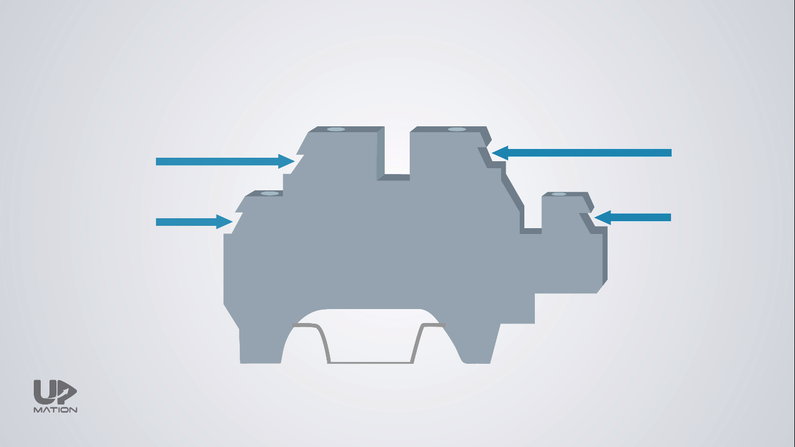
In the following, we have a branch that delivers the 24 volts power to page 12 column zero, but with two interlocks!
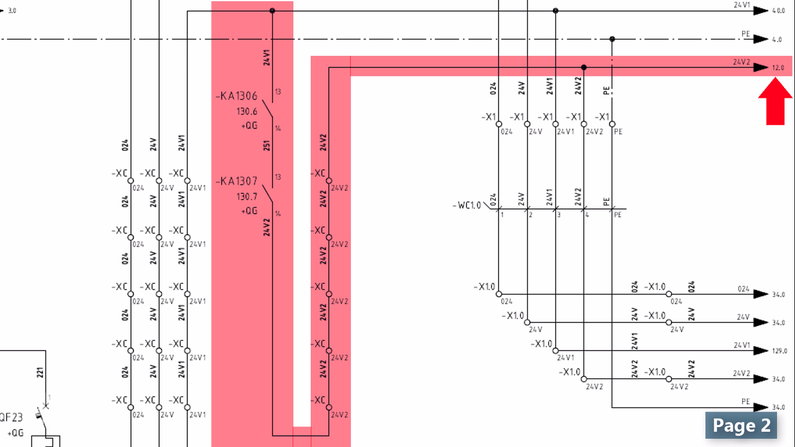
What is Electrical Interlocking?
An interlock means a condition.
For example, here, without having those interlocks enabled, our 24 v cannot reach page 12, column 0.
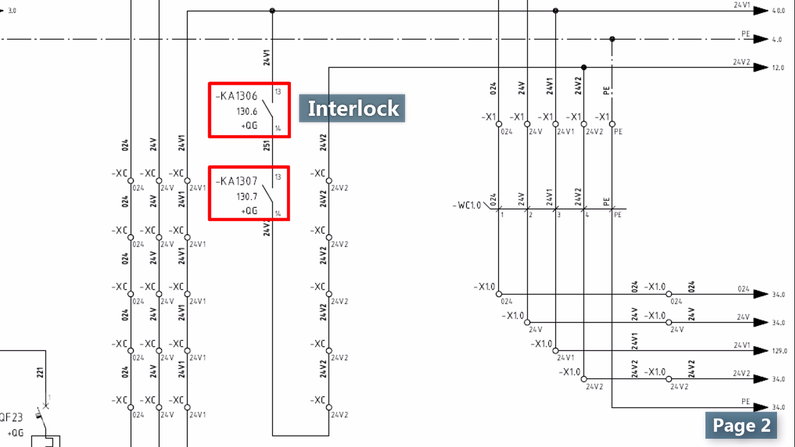
Let’s turn to page 130 of the wiring diagram again to see what those conditions are.
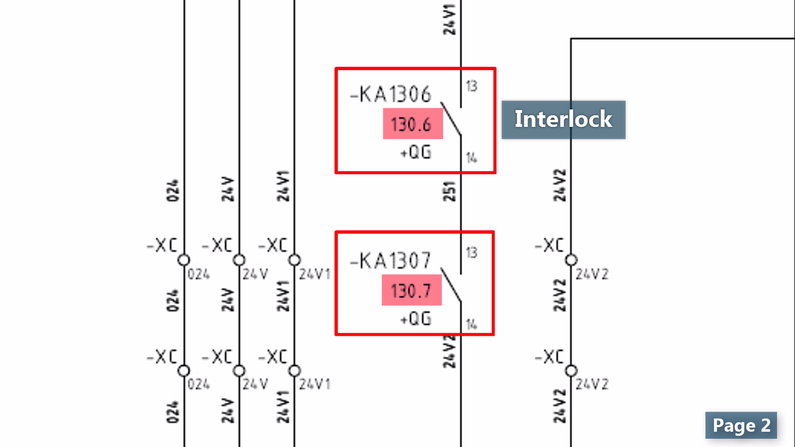
NOTE: Did you notice that we have to get back and forth between different pages? This is the only way we have to take to fully understand these drawings.
On page 130, we’ve a safety relay, and it will be used to protect people, material, and the machine itself when the machine is operating.
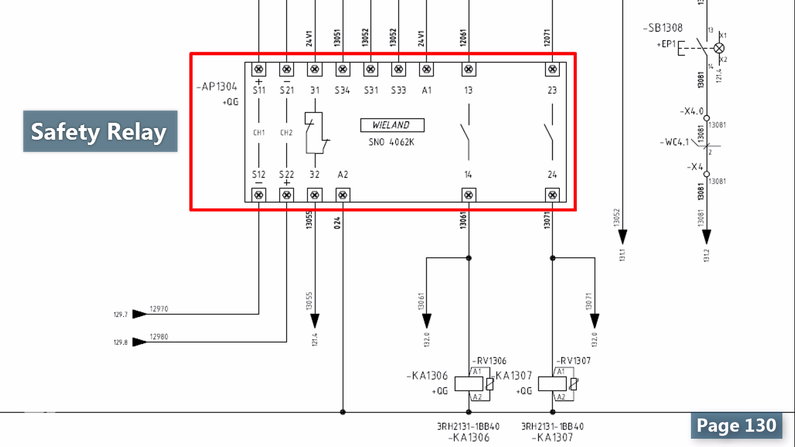
Remember that the designer of this wiring diagram had to refer to the datasheet of this equipment to complete his job.
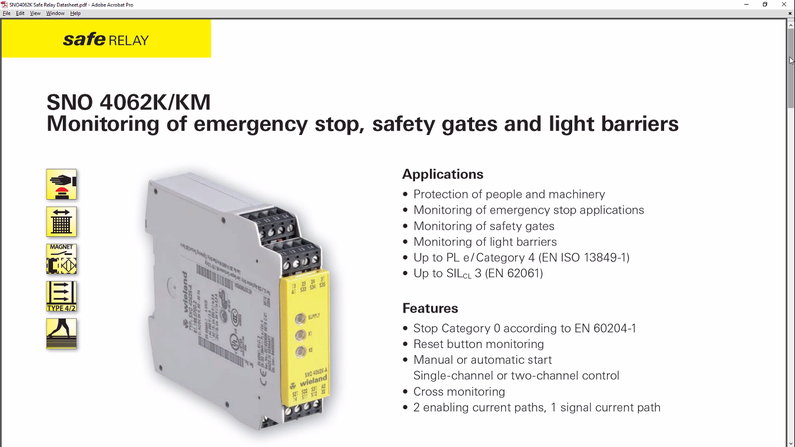
In fact, reading the datasheet of the equipment is a very important and inevitable stage of designing a wiring diagram.
We should always do the same thing for all of the equipment used in the process.

By the way, channels S11/S12 and S21/S22 are used to be connected to the safety components at the site (For example the safety barriers) and if the area is evacuated then these channels will be activated.
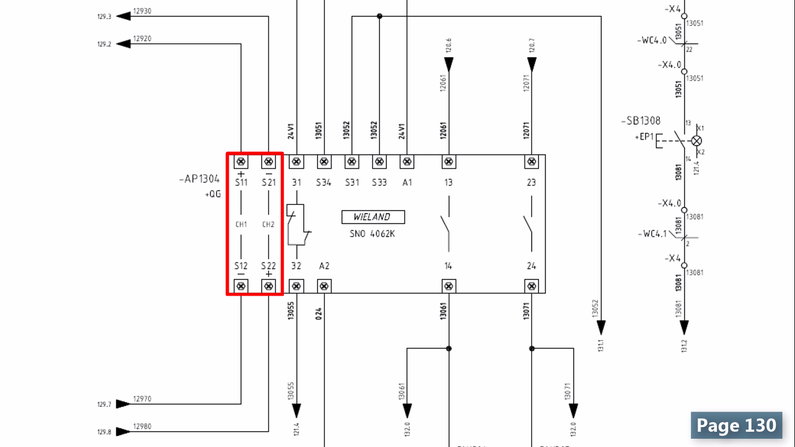
As a result, the NO contacts of the Safety Relay (Output Contacts 13/14 and 23/24) become closed.
Therefore, our 13-14 NO contacts of the relays (KA1306 and KA1307) become closed.
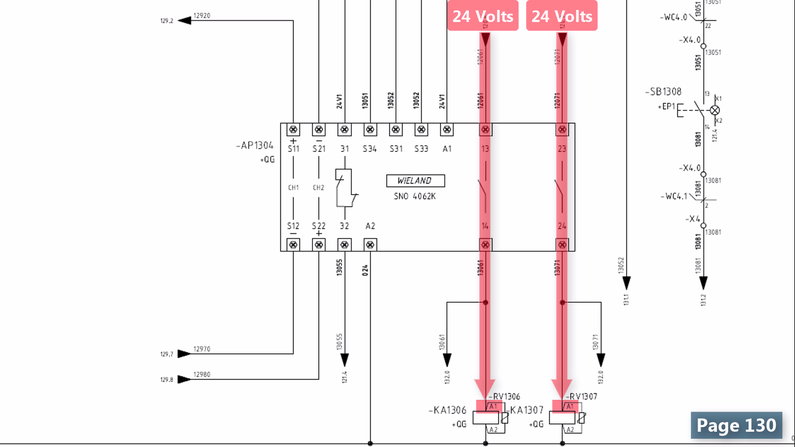
In this way, our 24-volt power will be transferred to page 12, column zero.
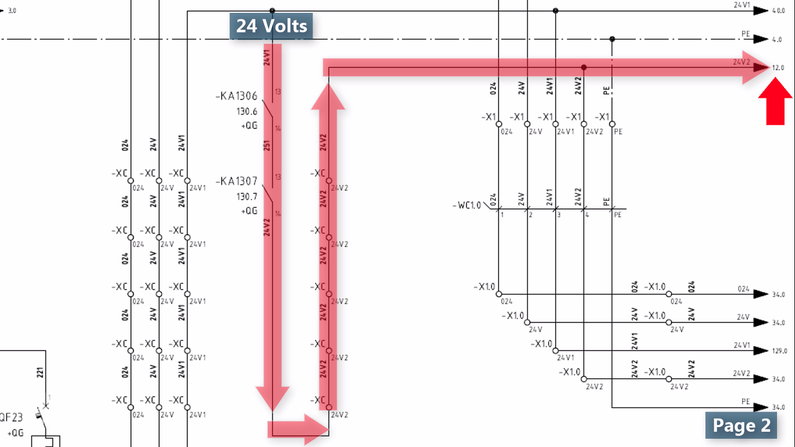
Let’s pause this part here and we’ll continue the next part by reading and understanding the PLC, VFD, and their power and signal cabling section of this control panel wiring diagram.
You can read Part 2 of this article here.
Thanks for reading another article. Please spread the word by sharing this article:

Please do a YouTube video series on this topic (How to Read Electrical Diagrams?).
Hi there! The upcoming video is the next part of this video series. Stay tuned!
Thanks for assisting me
You’re very welcome!
I really appreciate
You’re very welcome! Please let us know if you have any questions or suggestions.
Thanks
You’re welcome! Thank you for reading this article and watching the video!
this is awesome…….
Hey Mateo!
Happy you liked this blog post.
You can read the second part of this article here:
https://upmation.com/plc-wiring-diagram/
Please let us know if you have any questions or suggestions.
Please the video and pics on page are very small to see and its not zoomable in both tab and pc
Hi Ahmed, we are trying to add them to this blog post shortly.
Thanks for the good stuff. Indeed I have been looking for something like this.
Am glad to meet you. God bless you all.
Hey Emmanuel! You’re very welcome! Thank you very much for your visit. Please stay tuned for future videos.
Thanks for this great stuff.I really appreciate your effort in making sure that you simplify the entire system for people to understand
Well done.
Hi there! Happy it was helpful to you and thanks for your feedback.
Thank you. very good content. It is very helpful.
You’re very welcome! Thanks for following us!
Thank you so much for an easy and straightforward explanation.
You’re very welcome! It’s great to hear you liked the method of explanation.
excellent work!!!
Thank you! Happy you liked it!
Thank you sir ,
Radar level principle and bean angle please explain sir
You’re very welcome! I’ll transfer your suggestion to the team. Thank you!
Great effort! Thank you so much for such a nice blog and video series, and we are desperately waiting for the 3rd video of this video series 🙂
Hi Hamza! You’re very welcome! We try to publish that soon. Please stay tuned.
Thank you for the great blog and videos. I am still unclear; what is the minus sign before the tags “-KA1306” and plus sign “+QG”
Hey, Marc! You’re welcome!
The minus (-) signs are for the equipment (Contactors, relays, disconnector switches, instrument switches, pushbuttons, etc.).
The Plus (+) signs are for specifying the location of the equipment (Junction Boxes, electrical panels, etc.).
The Panel and JB’s names are defined by the manufacturer and the project’s team.
Outstanding!
I’m an electrical instructor, your videos make my life easier! Now, if I can only transfer my enthusiasm to the students!
Hi John! It’s really awesome to hear that! Sure you can!
And please don’t forget to give us your student’s feedback as well via this email address: [email protected]
It’s really important to us. Thank you!
very well ,this article has helped me a lot.
Thank you, Ted! Great to hear it helped!
Very helpful indeed. Is there any chance that one could be allow with PDF copies.
Thank you and happy it was helpful!
I’m afraid it is not possible to share the document. It is actually a copyrighted drawing.
Thanks for your understanding.
Ya il une version PDF de ce documentaire
Hi, can you send me the Pdf wiring diagrams o this exemple, Thanks
Hi there! I’m afraid, we cannot share this wiring diagram as it is a copyrighted document. Thank you for your understanding.
Hi,
May I know if you have a PDF or printable version of this article?
I would like to print this for self study.
Great article by the way. Thank you for the article.
Hey there!
I’m afraid we don’t have.
Thank you very much!
Hi, upmation
Your article is good.i love it
Hi, Fide! Thank you for your comment! It’s great to hear that!
Hi there!
Could you please share the designation codes for devices that you use in your projects (switches, isolators, contactors, relays, etc.)?
It could be great if you will share with us the Legend and abbreviation sheet.
Thanks a lot!
Hi upmation,,
How can download this pdf ?
Hi, Mehdi! Thank you for your comment. But We’re afraid we cannot share this document with you and our fans as this is a copyrighted document. Thank you for your understanding.
Great
Thank you, Leonard!
Awesome stuff!! Thank you so much for your step by step explanation
Thank you for your comment and we’re really happy you liked it this much!
Hi,
Thank you for making this wonderful piece available. Your guide and illustrations helps better understanding of the subject.
Thank you.
Hi there! You’re very welcome and thank you for your comment. It’s been amazing to hear such feedback! Let us know your comments about the other articles and videos available on the website.
PDF article of this vedeo??
I second this. Looking to print a PDF of the schematic if available!
Hi, Rob! Thank you for your comment!
This is actually a copyrighted piece of document. So we’re afraid we cannot share its complete version with our fans.
Thank you for your understanding!
I second this. Looking to print a PDF of the schematic if available!
This is very interesting, very clear about the subject.
Electrical Wire Harness Design
Great explaination. Could be understand well and used for my internship period
Glad it helped you! Good luck with your internship!
What a nice explanation Amirhossein! You are really helping me understanding complex diagrams. Now, I am confident enough to excel in Electrical and Instrumentation engineering field. May you have a wonderful life ahead.
Hi there! Thank you for your nice compliment! It’s fantastic to hear it helped you!
Hope you have an incredible journey in this field. Let us know if you have any questions down the road.
Hi, I´m Felipe I´d like to kwon about the videos to youtube cause i prefer to learn watching videos. Thanks
can you send me pictures from 1 and 2 part of article on my email?
Wiring diagrams can be very helpful when tracing electrical circuits, so people who work with them regularly should know how to read them. Nice job walking through this example.
That’s true indeed. Thank you!
In RF coaxial connector applications of the cables are required to offer a consistent level of impedance at the point where the links are made. This kind of cable is offered with shielding that serves to insulate the RF attenuator is carried through the link from interference from outside the cable.
great
Thank you, Haroun!
Hello,
I want to thank you for the amazing work you put into this.
However I have a question. On the terminals of -KA1307 on page 2, shouldn’t it be 23-24 instead of 13-14? Because on page 130.7, the terminals there read 23-24. Pls advise, because its a bit confusing to me.
Hi
Excellent explanation for a mechanical engineer like me who wants to learn and understand the electrical drawings.